?How did the “Sphinx” move between eras and civilizations and how did its shape evolve

"The Sphinx"... this squatting statue 10 kilometers from Cairo Governorate, next to the famous pyramids of Giza, this statue shrouded in much mystery, and although most scholars and researchers give credit for its construction to King Khafre, the Sphinx did not reveal its secrets. The discoveries revealed the existence of statues and designs very similar to the mysterious statue, and although they are not twins to the statue, it indicates that the creators of these works were heavily influenced by Egypt. Sphinx, and perhaps the reason for this similarity between these statues is the symbolism of the statue. Most researchers and scholars believe that the Sphinx symbolized the power of the ruler, the “Pharaoh”. In this report, we learn about the different statues and designs that were made with the same design as the Sphinx in different civilizations.
1- The Sphinx in the Old Kingdom
The Great Sphinx of Giza
It is a statue of a mythical creature with the body of a lion and the head of a human, carved from limestone. It is likely that it was originally plastered and colored, and traces of the original colors are still visible. next to one of his ears. It is located on the Giza Plateau on the west bank of the Nile and is the oldest known giant sculpture. Its length is approximately 73.5 meters, including 15 meters of the length of its front legs, and its width is 19.3 meters and its highest height above the ground is approximately 20 meters up 'at the top of the head.

1- The Great Sphinx of Giza
Opinions differ as to what this statue represents. The ancient opinion is that it represents King Khafre, combining the strength of a lion and the wisdom of man. Some archaeologists believe that it was King Khufu who built it, like the face of the Sphinx. looks like a statue of Cheops (and does not resemble the statues of Khafre). In fact, the question of which is the Sphinx building is still open to research.
It is said to represent the sun god "Hor-em-akhet", and the proof of this is the temple opposite the statue, where religious rituals were practiced, and this remained firmly ingrained in the minds of the Egyptians throughout the throughout their history, because they considered it a statue of the god "Hor-im-akhet", which means (Horus). On the horizon) is an image of the god Atum, the greatest of the Egyptian gods, who is the sun at sunset.
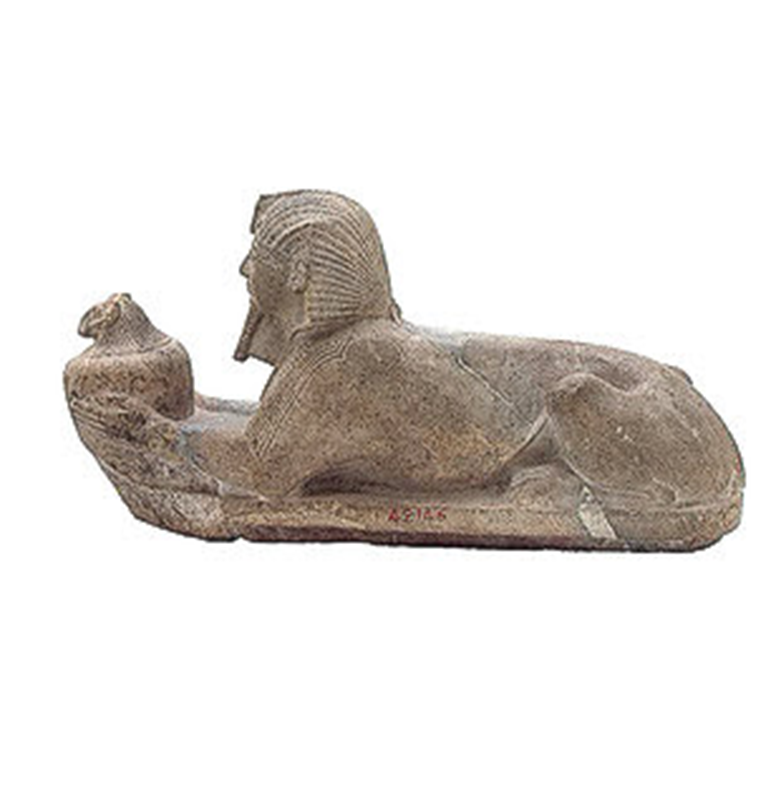
- A statue in the shape of a sphinx holding a pot in its hands
More than one pharaoh king visited the Sphinx, including Ramses II and King Tutankhamun, who set up a rest house next to the Sphinx.
Dr. Salim Hassan, in his book The Sphinx in the Light of Modern Discoveries, says of the Sphinx: It is a statue devoid of any written inscription speaking of its creator or its history, with the exception of a panel of geranium, which is nothing more than an addition placed long after the statue was made, and he describes the location of the Sphinx saying: "The Great Sphinx is located 10 kilometers from Cairo, next to the famous pyramids of Giza, a group which constitutes one of the most famous pyramids of Giza. wonders of the world", and it is likely that the statue belongs to King Khafre.
The Sphinx in the Middle Kingdom
The Middle Kingdom era witnessed a strong dynasty of powerful kings who led Egypt to an era of prosperity and featured a good group of statues that resemble the Sphinx, the most famous of which is perhaps -being the one known as the “Hyksos Sphinx” statues. , because the most famous of them is named after the Hyksos king Ayyubid, or the Tanisiyya statues, a reference to the place where it was found, and one of the characteristics of the statues of this era is that the head is that of a human while the ears are those of a lion, and the usual hairstyle of the Pharaohs has been replaced by lion's hair.
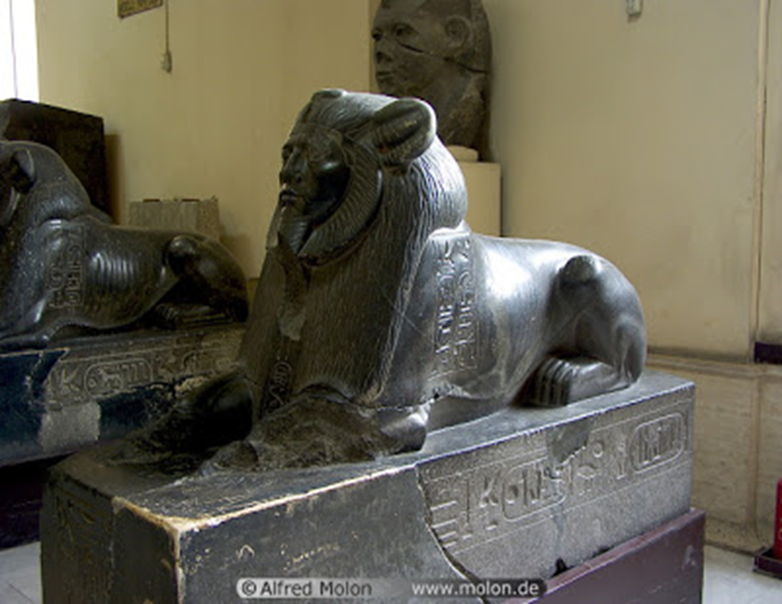
2- A statue resembling the Sphinx from the time of Amenemhat III
The statues of that era were distinguished by their strict features, which represented the kings of that era who were distinguished by their strength and severity. There is another style similar to the previous one, but devoid of severity and harsh features. It is made of limestone. , and came from “Al-Cape” in Upper Egypt. It was said that Queen Hatshepsut had usurped this statue, although it dates from the 18th dynasty, but she found in this statue something to satisfy her desire to appear powerful.
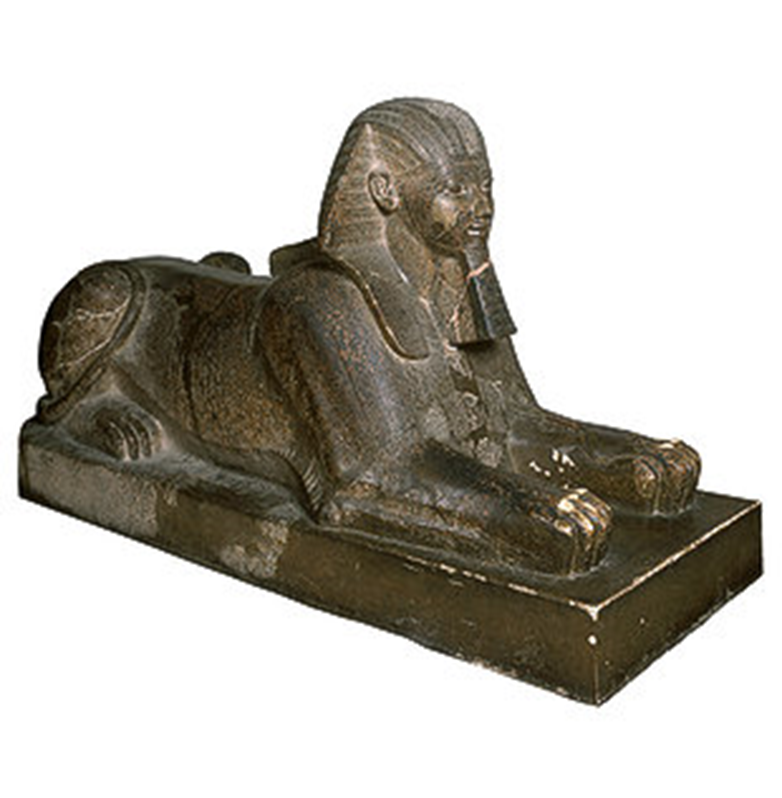
3- Une statue ressemblant au Sphinx du 18ème siècle
Quant à l'autre modèle, il s'agit d'un corps de lion portant un foulard sur les épaules et doté d'une tête humaine et d'une barbe droite. Cette statue est considérée comme le modèle idéal pour le Sphinx, et le modèle a évolué vers un nouveau sphinx avec une tête humaine et des bras humains. Cette évolution s'explique par des raisons artistiques, car les statues étaient représentées comme si elles effectuaient un travail avec les mains ou avançaient.

Image du Sphinx avec une main humaine
Mais la plupart des statues de cette époque furent usurpées par les souverains.
Le Sphinx au Nouvel Empire
À l'ère moderne, les statues ressemblant au Sphinx se sont considérablement développées en termes de taille et de forme. Les tailles sont devenues petites et minces, et les statues ont perdu leurs muscles et leur grande taille jusqu'à ressembler à des chats. Les statues ont abandonné leurs griffes et les ont remplacées par des griffes. des bras humains, et la tête du chien légendaire est apparue à l'époque préhistorique ont commencé à apparaître. Le lieu dynastique est la tête de certaines statues.

Legendary Dog's Head Statue
In the middle of the 18th dynasty, the cult of the Sphinx experienced a great renaissance. The Sphinx returned to its original image on their murals, but with some additions. Dr. Salim Hassan says in his book “The Sphinx in the Light of Modernity”. Discoveries”: He received (i.e. the style of the Sphinx). ) There are many novelties to his costume, because we see that in addition to the signs of the Old Kingdom, such as the mongoose and the royal uraeus, it was adorned with the long crown of the kings and gods, accompanied by a long necklace, falcon feathers and two folded wings.
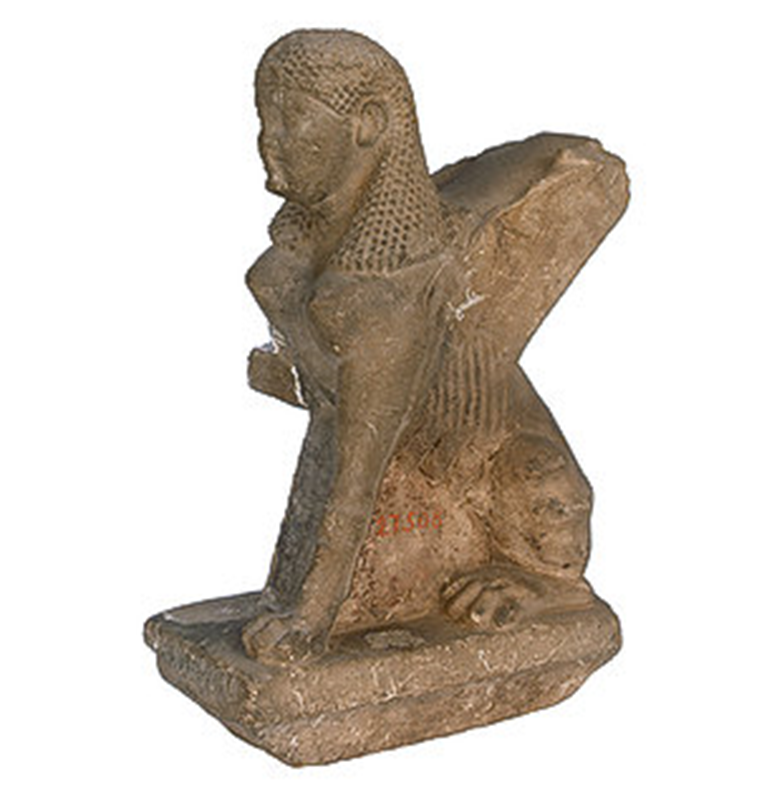
A statue in the shape of a sphinx with wings
Thutmose III's campaigns in Asia had a significant impact on the development of the Sphinx statues. For the first time the victorious Sphinx appeared, trampling his enemies under his feet. It was only at this time that the Sphinx abandoned its human head and replaced it. it with the head of the legendary dog or rams' heads like those found at the entrance to the temple.
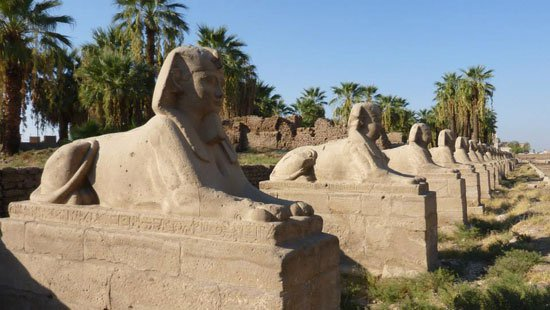
The Sphinx in Greek times
During the Greco-Roman era, three different styles (forms) of Sphinx statues appeared, one of them being the pure Egyptian style, which is a style that did not change from the traditional form of the Sphinx known in previous eras. the second is the pure Greek style, in which the statues appear in the form of a woman and mostly winged. As for the third, it was a mixture of Egyptian and Greek style. The dress on the statue's head was purely Egyptian, while the Greek style was purely Greek. the claws and crossed legs were Greek. In Greek times, most of what was glorified was printed on small coins. “Can’t get good photos”
The Sphinx outside Egypt
The Sphinx did not move through the ages only within Egypt, but rather it moved outside of Egypt, and as Dr. Omar Abu Zeid, Professor of Egyptian Antiquities at the Faculty of Archeology of Aswan University: This transfer is not so much due to the design of the Sphinx as to the transfer of the idea of showing power through the statue. This transfer is attributed to two reasons, the first being trade relations and the second the extension of the control and influence of the Egyptian state to the southern Anatolian mountains.
The Sphinx in Asia
The first appearance of the Sphinx in Asia was in the form of a lion with the head and wings of a bird of prey, and then an ivory statue of Nimrod appeared in Assyria.

A statue in the shape of a sphinx with wings
Just as the form of the Sphinx developed over previous eras and the face changed, there was a statue of one of the Assyrian kings. The change in shape of the Sphinx this time included the body, so the human face remained and the body of the statue changed from that of a lion to a winged bull.
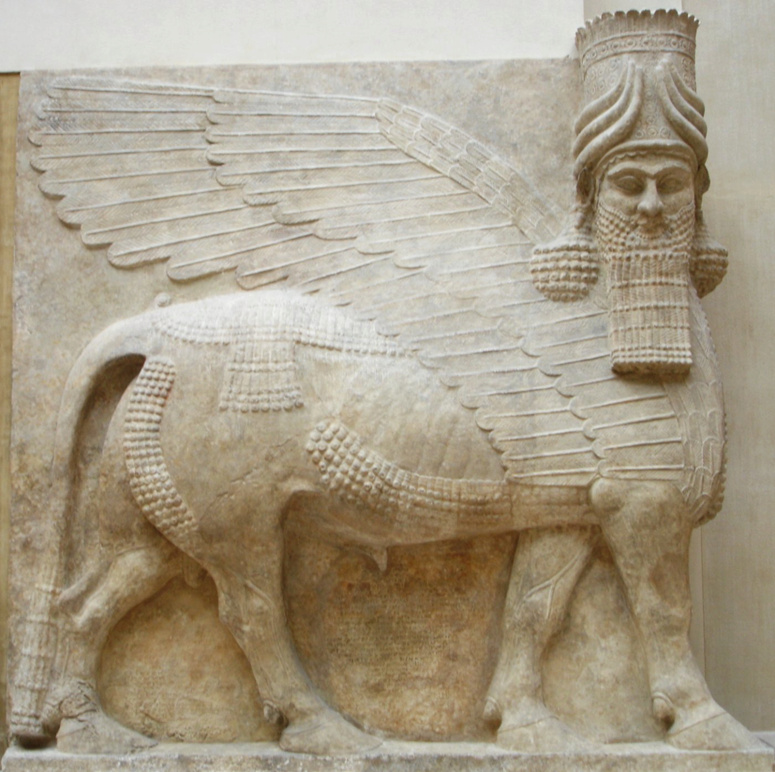
11- A statue with the body of a bull and a human head from Assyria
The Sphinx of Mycenae, Greece
The Sphinx did not settle in Asia, but its design went to Mycenae and Greece, where the Greeks fell in love with it, just as the Greeks loved it before, where it appeared in a particular style without losing its characteristics that reflect its Egyptian origin. Perhaps its most notable appearance is that which appears in the myth of “Oedipus”. ", where he was depicted in the form of a monster attacking their land and imposing tribute on the victims who passed by. Greek sculptors and carvers were influenced by the ancient Egyptian civilization in their works, and most importantly of between them was the Greek sculptor Phidias.
The Sphinx in the Greek century
The eagle-headed lion appeared in frescoes from the time of Minos, indicating that Greek art was influenced by the Pharaonic civilization. Dr. Salim Hassan says in his book The Sphinx in the Light of Modern Discoveries: "At the time of the 18th dynasty, Egypt entered into close relations with... Cyprus, where an important commercial transaction took place between them, did not fail to have an impact on the art of both countries, even if Egypt kept the appearance that it gave more than was necessary." He continues: "However, the Egyptian elements began to diminish over time, as if artists were beginning to draw inspiration from the Asian Sphinx. The statues of winged sphinxes on the sarcophagus (Amatonte) have little in common with the statues of winged sphinxes on the sarcophagus (Amatonte). Egyptian, with the exception of the hidden and underlying idea which links them to the protection of the deceased.
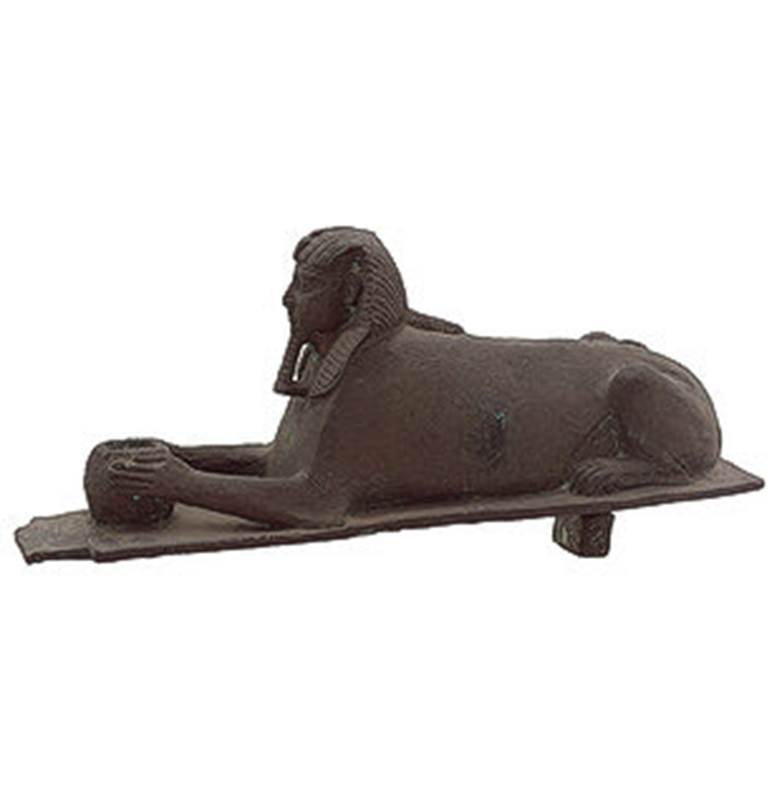
A sphinx-shaped statue with two human hands
Source: websites

